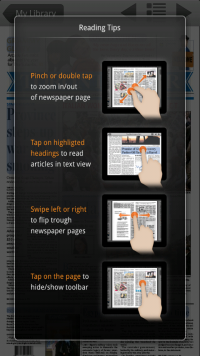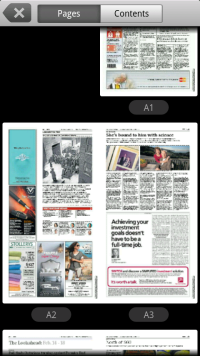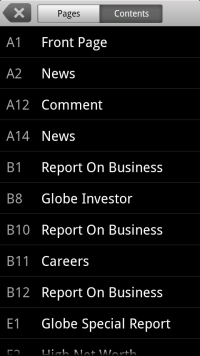Though the business of journalism is in flux right now, people are taking chances in order to fix it. Whether it’s trying new methods of content delivery, or new methods of payment, the important thing is that people are trying.
PressReader is one of those attempts. Essentially, when you pay a subscription to their service, you are free to download newspapers from over 79 countries around the world. These newspapers are updated daily, which means you’ll always be up to date; you can download them on a per-issue basis or set up a subscription, so issues are downloaded daily.
When you select a paper to read, you are treated to what looks like a scan of that day’s issue. You can swipe left and right to change pages, or access a full table of contents from a menu (see above). This makes the experience seem quite authentic; it gives people who enjoy the aesthetic of a newspaper something to enjoy, as well. From there, you click on individual headlines, which will then bring you to a zoomed-in version of the article. This isn’t just an enlarged scan; they’re a reformatted page (with all the associated media) that allows for easy reading. It’s very simple, but it works.
There’s a lot to like about PressReader; it scrolls through issues extremely fast and works extremely well; the pages of the paper don’t look scanned at all. The click-able objects on each page are highlighted with a nice blue color, making it apparent what’s interactive. Incomplete columns are presented in their entirety: you don’t have to start something on A1 and finish it on A13. It’s these little things that make PressReader work; if there were too many screw-ups, it would be very easy to dismiss.
There’s a glaring problem with it, though. Something too big to ignore.
It’s the fact that most users who would take the time to download PressReader are not willing to pay for their news. At $29.95 USD per month, the only people I can picture spending money on it would be those of us who read multiple newspapers from around the world daily; in a world of RSS and most papers having the exact same content on their websites for free, paying to read the same thing from a “newspaper” seems a little ludicrous.
http://www.youtube.com/watch?v=Lj3PhPkoNYc
For those not wanting to shell out for an unlimited plan, a “credit” system is in place that allows for users to pay as they go. However, this credit system is at the publisher’s pricing: one credit ($.99 each) does not always equal one newspaper.
It’s actually quite difficult to make the decision to recommend PressReader to you or not. On one hand, the app works amazingly, and there’s something about having the whole paper in your hand that makes it all the more better when you find a story you weren’t quite looking for – one that your RSS reader might have missed.
This application also screams to be used on a tablet, as its touch controls are extremely slick. It lacks the polish of apps specifically made for that paper – you won’t find any fancy page-turn animations, slideshows or video content here – but if you’re looking to read a paper that doesn’t have its own digital edition, this is a good place to find it.
On the other hand, that same article is free with a little bit of searching, and having to download and maintain a collection of newspapers isn’t always the most efficient way of getting your news.
Ultimately, your answer hinges on how much you love the news. Whether or not you’re skeptical about the way journalism is headed, give PressReader a try. Its free trial gets you seven free issues, and from there you can decide how much you’re willing to pay for your news.
—
Matt Demers is Droid Life’s app guy and a journalism student, He would pay for a subscription if he owned a tablet and didn’t have to worry about groceries this week. You can find him on Twitter, or his new personal site.



Collapse Show Comments9 Comments